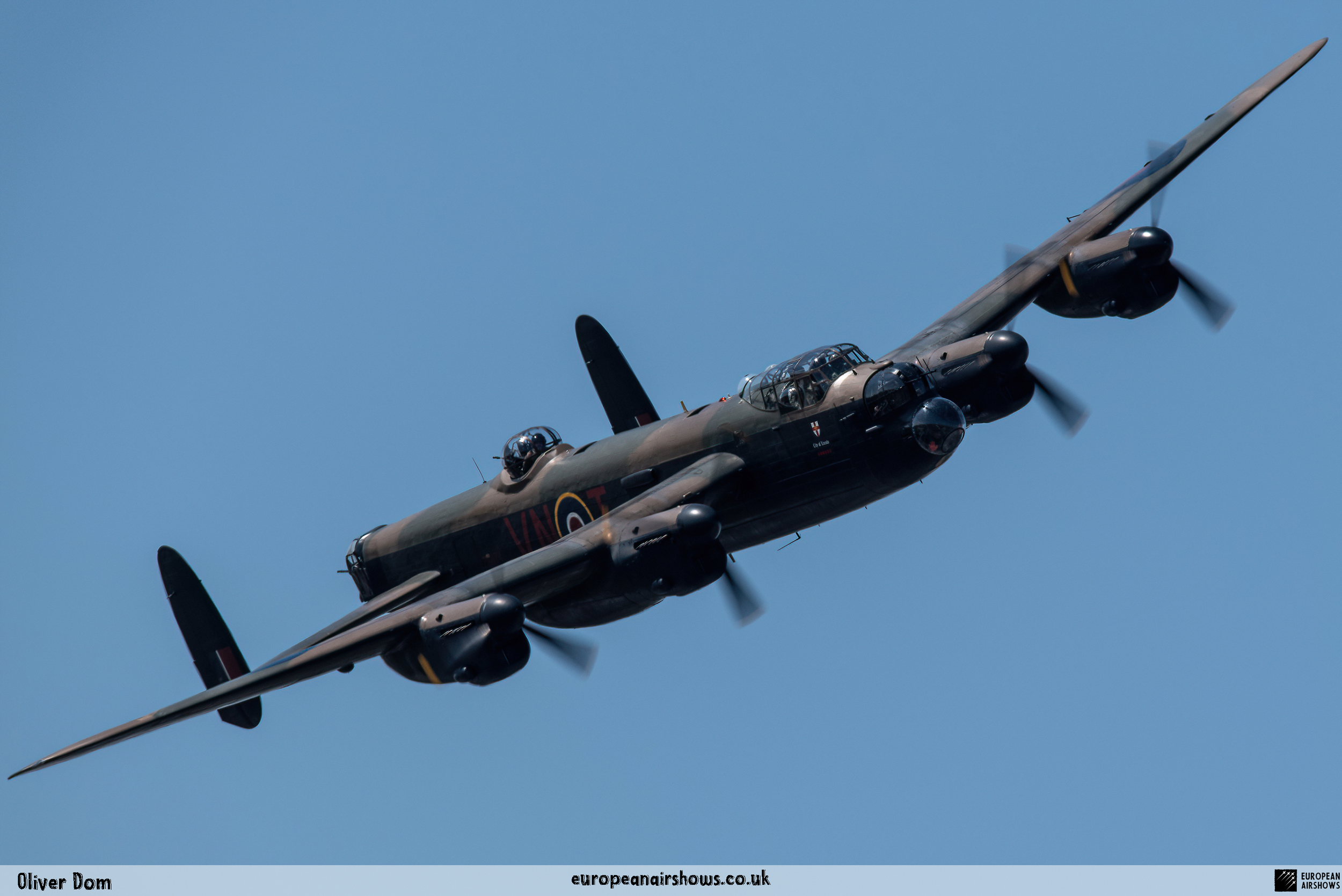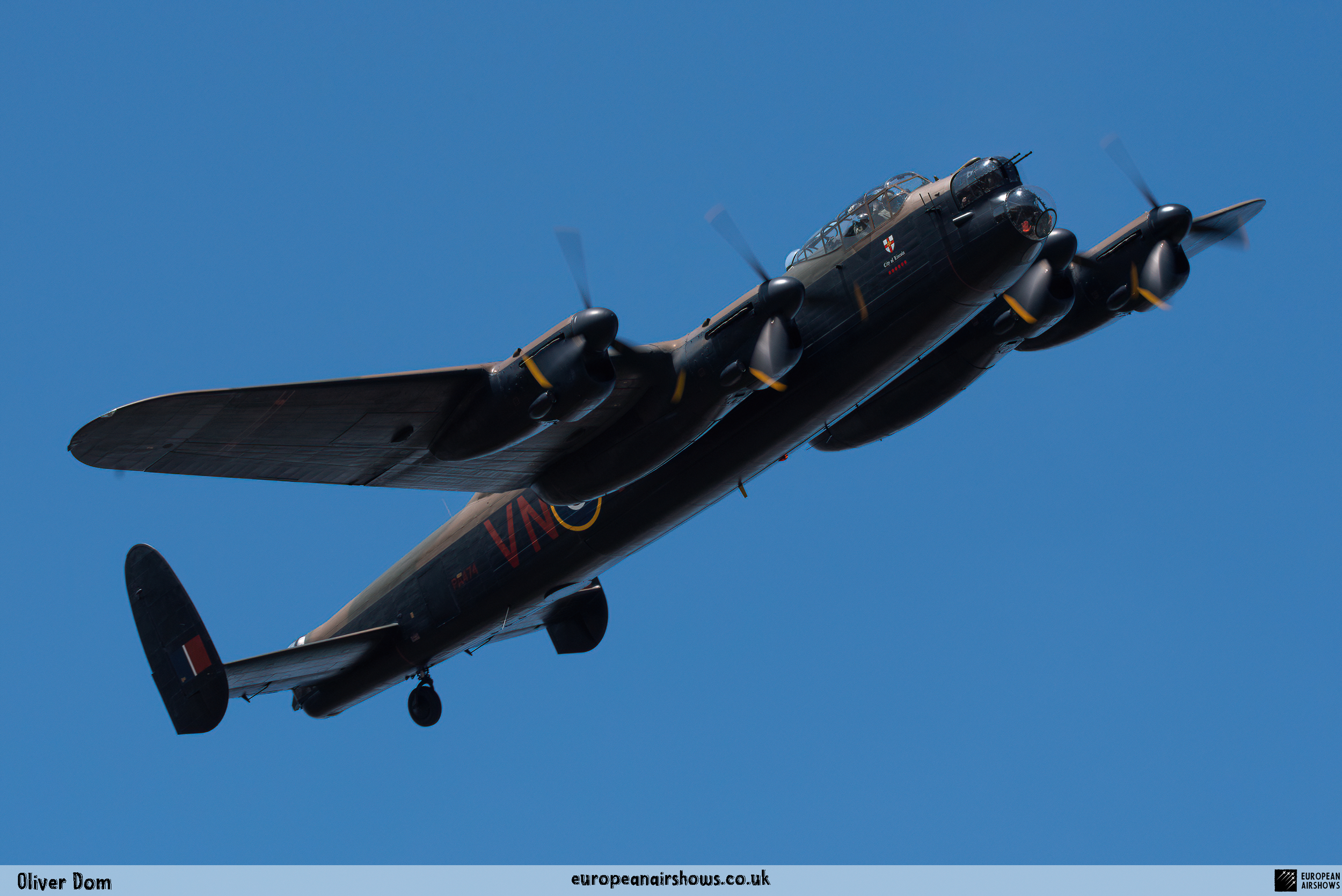Lancaster bomber to fly over Belgium and Netherlands for commemorative flight
Plane spotters and people with a keen interest in the history of the Second World War are in for a real treat, on the 4th of May the BBMF Lancaster bomber will perform a number of flypasts across Belgium and the Netherlands (details on the flypasts below).
The Lancaster bomber acquired by the BBMF in 1973, is one of only two surviving airworthy examples of the type; the other is in Canada.
She was built in mid-1945 and assigned to reconnaissance duties after appearing too late to take part in the bombing of Japan. After various duties, she was adopted by the Air Historical Branch for display work. She appeared in two films: Operation Crossbow and The Guns of Navarone. Having been flown for much of her service with the BBMF as the "City of Lincoln", PA474 previously wore the markings of the "Phantom of the Ruhr", a Lancaster that flew 121 sorties (a so-called "ton-up" Lancaster). Originally assigned to 100 Squadron in June 1943, the original "Phantom" was transferred to 101 Squadron in November that year and finished the war as part of 550 Squadron at Ludford Magna. The Lancaster currently carries two markings. On the left-hand side, she carries the markings of AR-L 'Leader', which served with No 460 Squadron (RAAF). On the right-hand side, she carries the markings of the 50 Squadron code letters VN-T, representing the Lancaster flown by FO Douglas Millikin DFC.
Lancaster with two Spitfires and a Hurricane
Lancaster Bomber
The Avro Lancaster is a British Second World War heavy bomber. It was designed and manufactured by Avro as a contemporary of the Handley Page Halifax, both bombers having been developed to the same specification, as well as the Short Stirling, all three aircraft being four-engined heavy bombers adopted by the Royal Air Force (RAF) during the same wartime era.
The Lancaster has its origins in the twin-engine Avro Manchester which had been developed during the late 1930s in response to the Air Ministry Specification P.13/36 for a capable medium bomber for "worldwide use". Originally developed as an evolution of the Manchester (which had proved troublesome in service and was retired in 1942), the Lancaster was designed by Roy Chadwick and powered by four Rolls-Royce Merlins and in one version, Bristol Hercules engines. It first saw service with RAF Bomber Command in 1942 and as the strategic bombing offensive over Europe gathered momentum, it was the main aircraft for the night-time bombing campaigns that followed. As increasing numbers of the type were produced, it became the principal heavy bomber used by the RAF, the RCAF and squadrons from other Commonwealth and European countries serving within the RAF, overshadowing the Halifax and Stirling.
A long, unobstructed bomb bay meant that the Lancaster could take the largest bombs used by the RAF, including the 4,000 lb (1,800 kg), 8,000 lb (3,600 kg) and 12,000 lb (5,400 kg) blockbusters, loads often supplemented with smaller bombs or incendiaries. The "Lanc", as it was known colloquially, became one of the most heavily used of the Second World War night bombers, "delivering 608,612 long tons of bombs in 156,000 sorties". The versatility of the Lancaster was such that it was chosen to equip 617 Squadron and was modified to carry the Upkeep "bouncing bomb" designed by Barnes Wallis for Operation Chastise, the attack on German Ruhr valley dams. Although the Lancaster was primarily a night bomber, it excelled in many other roles, including daylight precision bombing, for which some Lancasters were adapted to carry the 12,000 lb (5,400 kg) Tallboy and then the 22,000 lb (10,000 kg) Grand Slam earthquake bombs (also designed by Wallis). This was the largest payload of any bomber in the war.
The route
The Battle of Britain Memorial Flight Lancaster is expected to perform a series of Liberation Day flypasts over Belgium and the Netherlands on Thursday 4th May 2023.
The Lancaster Bomber played an important part in the Liberation of the Continent, and this flight also serves as a commemoration of Operation Manna which saw the Lancaster used in a humanitarian capacity, delivering food and supplies to those in need in the Netherlands.
The planned route-
12:58LT - Knokke-Heist (Belgium)
13:11LT - Velzeke (Belgium)
13:13LT - Lierde (Belgium)
13:18LT - Rebecq (Belgium)
13:29LT - Heverlee (Belgium)
13:41LT - Sanicole (Belgium)
13:48LT - Mol (Belgium)
13:51LT - Gierle (Belgium)
13:53LT - Heihuizen (Belgium)
13:58LT - Ekeren (Belgium)
14:10LT - Gilze Rijen Airbase (Nehterlands)
14:27LT - Tabaksweg (Nehterlands)
14:36LT - Hal (Netherlands)
14:40LT - Bathmen (Netherlands)
14:46LT - Den Ham (Netherlands)
14:49LT - Sibcul (Netherlands)
14:54LT - Alteveer (Netherlands)
15:07LT - Eelderwolde (Netherlands)
15:23LT - Harlingen (Netherlands)
15:33LT - Texel (Netherlands)
15:41LT - Nieuwe Niedorp (Netherlands)
15:44LT - Bergen (Netherlands)
Lancaster at RIAT 2022
The Official Statement
Statement from the Battle of Britain Memorial Flight
“On Thursday 4th May, we’re delighted to announce that once again the BBMF Lancaster PA474, one of only two flying Lancaster Bomber aircraft still in airworthy condition, will be flying a commemorative sortie over Belgium and the Netherlands. The Lancaster Bomber played an important part in the Liberation of the Continent, and this flight also serves as a commemoration of Operation Manna which saw the Lancaster used in a humanitarian capacity, delivering food and supplies to those in need in the Netherlands. As opportunities to leave the British mainland are quite rare, the sortie comprising of 22 flypast sites will certainly be one to look out for!”












